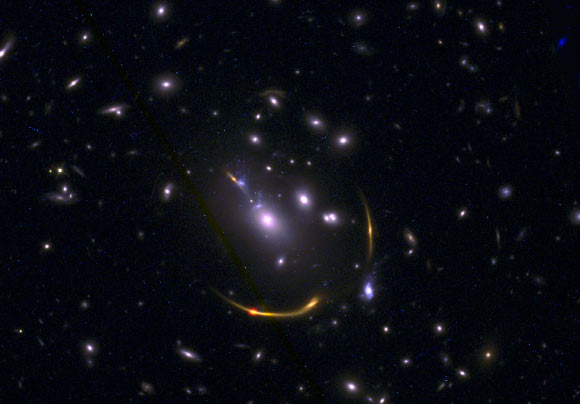Massive galaxies in the early Universe should have contained large amounts of cold molecular gas, the fuel required to make stars. But new observations from the Atacama Large Millimeter/submillimeter Array (ALMA) and the NASA/ESA Hubble Space Telescope show that these galaxies had extremely little dust at early times, and by proxy very little molecular gas; the implication is that the early galaxies shut off star formation because their reservoir of molecular gas was rapidly depleted or removed.

This composite image of the galaxy cluster MACSJ 0138 shows data from ALMA and Hubble. Image credit: ALMA / ESO / NAOJ / NRAO / S. Dagnello, NRAO / STScI / Whitaker et al.
“The most massive galaxies in the Universe lived fast and furious, creating their stars in a remarkably short amount of time,” said Dr. Kate Whitaker, an astronomer at the University of Massachusetts, Amherst.
“Gas, the fuel of star formation, should be plentiful at these early times in the Universe.”
“We originally believed that these quenched galaxies hit the brakes just a few billion years after the Big Bang.”
“In our new research, we’ve concluded that early galaxies didn’t actually put the brakes on, but rather, they were running on empty.”
Using ALMA and Hubble, Dr. Whitaker and her colleagues observed six strongly lensed galaxies: MRG-M134115, MRG-M013816, MRG-M212917, MRG-M015016, MRG-M045418, and MRG-M142318.
The study was part of the REsolving QUIEscent Magnified (REQUIEM) galaxy survey, which uses extremely massive foreground galaxy clusters as natural telescopes.
The observations revealed the target galaxies’ continuum emission — a tracer of dust — at millimeter wavelengths, allowing the authors to infer the amount of gas in the galaxies.
The team found that the cessation of star formation in these galaxies was not caused by a sudden inefficiency in the conversion of cold gas to stars. Instead, it was the result of the depletion or removal of the gas reservoirs in the galaxies.
“We don’t yet understand why this happens, but possible explanations could be that either the primary gas supply fueling the galaxy is cut off, or perhaps a supermassive black hole is injecting energy that keeps the gas in the galaxy hot,” said Dr. Christina Williams, an astronomer at the University of Arizona.
“Essentially, this means that the galaxies are unable to refill the fuel tank, and thus, unable to restart the engine on star production.”
Although the astronomers now know that these galaxies are running on empty and that something is keeping them from refilling the tank and from forming new stars, the study represents just the first in a series of inquiries into what made early massive galaxies go, or not.
“We still have so much to learn about why the most massive galaxies formed so early in the Universe and why they shut down their star formation when so much cold gas was readily available to them,” Dr. Whitaker said.
“The mere fact that these massive beasts of the cosmos formed 100 billion stars within about a billion years and then suddenly shut down their star formation is a mystery we would all love to solve, and REQUIEM has provided the first clue.”
The team’s results appear in the journal Nature.
_____
K.E. Whitaker et al. 2021. Quenching of star formation from a lack of inflowing gas to galaxies. Nature 597, 485-488; doi: 10.1038/s41586-021-03806-7







